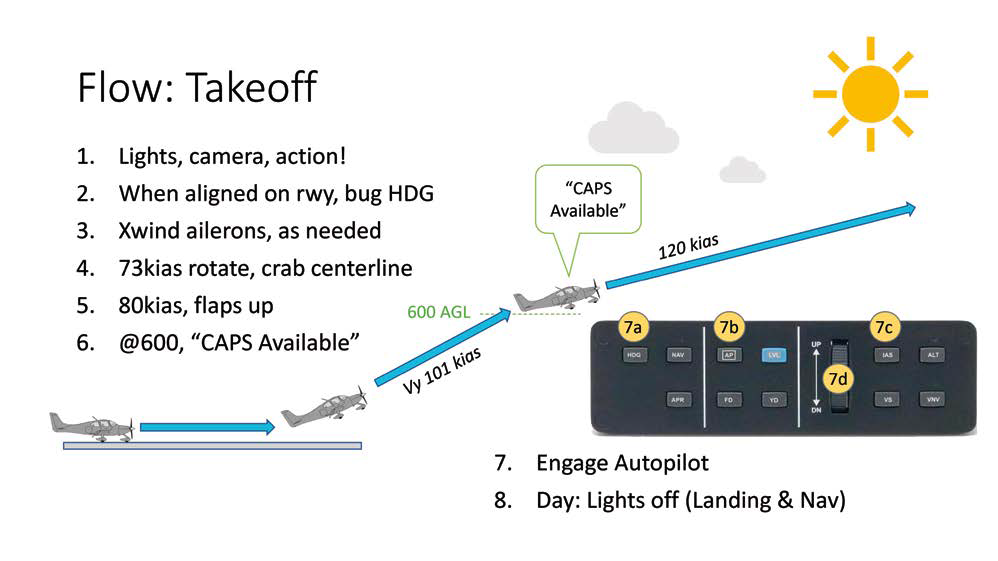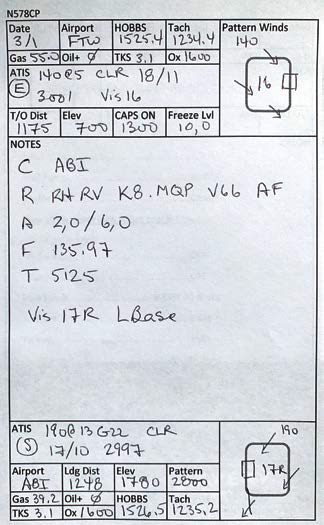Anytime I am headed to my hangar, airborne in my 2008 SR22TN or landing at my destination, the gleeful feeling of “glad to be here” is hard to ignore. That phrase brings to mind a documentary I watched years ago about the Blue Angels. “Glad to be here” was their ritual greeting at the start of their flight debrief, before analyzing the pros to reinforce and the cons to address from their flight. This humility and continuous improvement mindset struck a loud chord with me then and is no less diminished now as I near my 600th flight hour.
I’ll be honest: there’s usually some good, bad and ugly in every one of my flights – and the opportunity to learn something new every time. With Cirrus best practices, we have checklists from preflight to shutdown, and briefings for takeoffs, approaches and landings. But what about a flight debrief to learn from our successes and mistakes? Certainly, this is easier to perform with an instructor during formal training, but how can you formalize and facilitate this when you are “really” flying? Also, how can you fit this in, when all too often the end of a flight is not the most convenient time to reflect?
As with noting a squawk for later maintenance or repair, a constructive approach is to note the experience of interest. It is probably best not to do so in your formal logbook, but simply jotting a note on your smartphone, EFB or good old piece of paper with an approximate time. Within a day or two, take the time for some mental review.
Unfortunately, your memory may not always be accurate. In other words, our excitement and task saturation may cloud our memory, as does the elapsed time since the flight. Sometimes, the approach may have been more stabilized than you thought, you did not blabber as foolishly with ATC as you feared or you didn’t take as long of time as you believed. Other times, it was much worse! Here are some ways to tap objective information:
- A GoPro in the cockpit with a COM audio cable, positioning the view over the cowling and ideally capturing the avionics interaction.Batteries can be refreshed for long flights, the cabin and radio audio is already synchronized with the video, and the audio spans all the frequencies used during the flight. (This is also REALLY helpful to review your formal training flights!)
- Avionics data recording on an SD card. In the case of Perspective+, the MFD will snapshot a plethora of details every second. This data can be parsed by several clever tools such as SavvyAviation.com and CloudAhoy.com. On a recent flight through an insanely busy Bravo, I did not have my GoPro and audio recordings. I used the SavvyAviation tool to retrieve the frequencies I used and when, guiding me to which liveATC.net archives to pull for study.
- On shorter flights, a GoPro under the wing filming the landing gear or facing forward (which should include the nosewheel). Nothing beats these views of your flares and crosswind touchdowns when refining or verifying your landing performance. (I use GoPro’s WiFi control to selectively record phases of flight to help extend the battery endurance on longer flights.)
- FlightAware.com or similar flighttrackers can give you locations, altitudes and speeds throughout your flight, although the aforementioned CloudAhoy will break down flight performance into much richer detail.

MYFOM: With little time to think, a smooth takeoff flow keeps me in the zone.
Some events are just straightforward gotchas that are easy to recall. For example, forgetting to enrich the mixture for takeoff, or realizing on a long crosscountry flight you could have noticed MUCH earlier those low ceilings forecast to rise by your arrival time were doing no such thing!
After doing the review it's time to consider if there was something you saw that is worthy of a change. There are a few considerations. Was it uncomfortable or terrifying? Was it a recurring situation? How easy might you have resolved it?

AFTER TRYING DIFFERENT METHODS, surprisingly it was better for me to go back to paper.
I usually fold in easy and affordable improvements, such as:
- I now ensure my mixture is full rich at takeoff by “dangling” my pinky when applying full power. If the mixture is still lean, my pinky will catch the knob and pull it forward. I will chide myself but be glad I caught it.
- On cross-country flights, I now look at the inflight METARs of the destination and nearby stations early on and throughout my flight.
- Regarding in-cockpit weather, after trying out both ADS-B and SiriusXM weather services when around some dicey IMC, I opted for the paid SiriusXM service. On my Perspective, SiriusXM delivered more features such as winds aloft, and better features such as higher resolution radar and lightning along with faster weather updates.
- My shutdown routine now pauses with only the battery switches on so I take two pics with my phone – the engine screen and my flight meters – then I turn off the batteries. This way I won’t forget my remaining gas, oxygen and TKS.

MYFOM: Staying ahead of the aircraft begins early with simple flows.
Not all fixes are this easy. For example, a weakness I noticed with my flying was forgetting to reapply power after an altitude stepdown when my attention is saturated (e.g., while doing an instrument approach in IMC or executing a teardrop entry to an unfamiliar, non-towered field with a busy pattern). I believed adding an Angle of Attack (AoA) HUD solution would be immensely helpful, but found it cost-prohibitive for me. Consequently, this is an area I hammer with pitch and power practice to strengthen.
Many self-improvements are flow optimizations or additions. A place to capture this that has really helped me is what I call a “myFOM.” The Cirrus iFOM is a fantastic multimedia manual, however, it is fairly detailed and lengthy and I cannot customize the material or add my own words. In contrast, myFOM is a personal PowerPoint file I created to capture some key iFOM practices and insights picked up from other educational sources including training sessions, CPPP events, YouTube videos, etc. This is also where I supplement with my own enhancements, especially in-cockpit flows and avionics procedures I refined through experience and experimentation. Chair flying is easier for me when I can paste into PowerPoint some avionics images and overlay some numbers for flow sequences. In my own words and in my own organization, myFOM is my ultimate review cheat sheet that continually improves.
After some experimentation within the cockpit, I surprised myself by going back to paper for ATIS, CRAFT and other inflight notes. I crafted an Excel spreadsheet for a perfect half-sheet to fit in a 5.5 x 8.5 half-inch 3-ring binder. Meanwhile, my ForeFlight EFB still shines for flight planning, custom checklists, imported documents and of course a backup for charts and other flight information. But by and large, the EFB rarely comes out inflight in my cockpit.
My experience has been a work in progress, one I intend to refine without end. Hopefully, some of the tips and tools I mentioned will help you debrief your flights or, when grounded during your airplane’s annual inspection, perform a thorough selfreflection. Whatever your piloting stage, whatever your learning style, continuous improvement should keep all of us “glad to be here” for a very long time.
This article was initially published in the April 2021 issue of COPA Pilot.